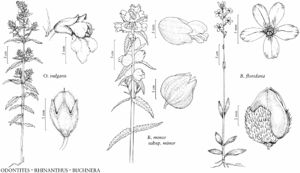Rhinanthus minor subsp. minor
Stems 5–20 (–55) cm, glabrous. Leaves: blade dark green, ovate-oblong to linear-lanceolate, margins crenate-serrate, distal leaves sometimes dentate. Bracts longer than to slightly shorter than calyx, glabrous, sometimes somewhat scabrid, teeth bristle-tipped. Corollas 13–15 mm; throat moreorless open; teeth of galea bluish or bluish gray, apex rounded, acute, or truncate-acute. 2n = 22.
Phenology: Flowering summer.
Habitat: Clearings, meadows, rocky slopes, open, grassy slopes at edges of mixed woods, roadsides, often on calcareous soils or rocks.
Elevation: 0–600(–2700) m.
Distribution
Introduced; Greenland, St. Pierre and Miquelon, Alta., B.C., Man., N.B., Nfld. and Labr., N.W.T., N.S., Ont., P.E.I., Que., Sask., Alaska, Ariz., Colo., Conn., Idaho, Maine, Mass., Mich., Mont., N.Mex., N.Y., Oreg., Wash., Wis., Europe
Discussion
The name Rhinanthus crista-galli has been misapplied to R. minor by numerous European and American authors. All reports of R. crista-galli from eastern North America appear to be based on subsp. minor. Reports of subsp. minor from North Dakota and Rhode Island are probably erroneous; confirming specimens could not be found. Populations of subsp. minor usually are associated with some type of anthropogenic disturbance.
Selected References
None.
